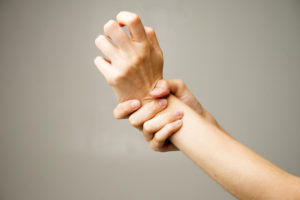
By Chen Li – BAppSc(Phty), Hand Therapy Group Physiotherapist, Accredited Hand Therapist (AHTA), Certified Hand Therapist (USA)
 Working at a desk everyday can be very taxing on your hands and wrist due to constant typing, writing and body posture. An incorrect set up at work or in your home office can increase the likelihood of an injury. Some individuals may even start to experience pins and needles or numbness in their fingers, or pain and swelling in the wrist or fingers.
Working at a desk everyday can be very taxing on your hands and wrist due to constant typing, writing and body posture. An incorrect set up at work or in your home office can increase the likelihood of an injury. Some individuals may even start to experience pins and needles or numbness in their fingers, or pain and swelling in the wrist or fingers.
Below we take a look at the common wrist and hand injuries associated with sitting at a desk all day.
Common wrist and hand injuries associated with sitting at a desk all day:
Carpal tunnel syndrome
Carpal tunnel syndrome is compression of the median nerve that passes through the carpal tunnel at the wrist. It can be caused by constant pressure at your wrist whilst typing or typing with your wrist flexed. Symptoms include numbness, tingling, and pins and needles of the thumb, index finger, middle finger and ring finger. You may also experience pain and weakness of your hand or thumb.
 Wrist tendinitis
Wrist tendinitis
Constant computer work can put stress on your wrist muscles and joints, leading to inflammation of tendons that attach to the wrist. Symptoms can include pain with wrist or thumb movement, or swelling around the wrist. You may also experience muscle cramping or tightness in forearm muscles.
Finger tendinitis
Repetitive typing can place a lot of strain on finger tendons, leading to inflammation of tendons. If left untreated, swelling of fingers may limit finger movement, which can also lead to clicking or locking of fingers.
 Ways to prevent injuries associated with working at home:
Ways to prevent injuries associated with working at home:
- Have a good ergonomic set up at your desk at home. Your feet should be flat on the floor with hips and knees bent at 90 degrees. Your screen monitor should be an arm’s length away.
- Take a break from sitting in front of the computer. This could include going for a short walk around the neighbourhood or standing up to stretch your back or hamstrings.
How a Hand Therapist can help:
A Hand Therapist will provide a full assessment and treatment plan designed specifically for you. Treatment may include:
- Splinting to support affected tendons, muscles or relieve nerve compression
- Advice on activity modification, posture correction and ergonomic set up
- Provide exercises to glide affected nerves and strengthening muscles to improve endurance
 If you are experiencing any of these symptoms, get in touch with our of our clinics today that specialises in treatment of the hand and upper limb, such as Hand Therapy. Click here to submit an enquiry.
If you are experiencing any of these symptoms, get in touch with our of our clinics today that specialises in treatment of the hand and upper limb, such as Hand Therapy. Click here to submit an enquiry.
